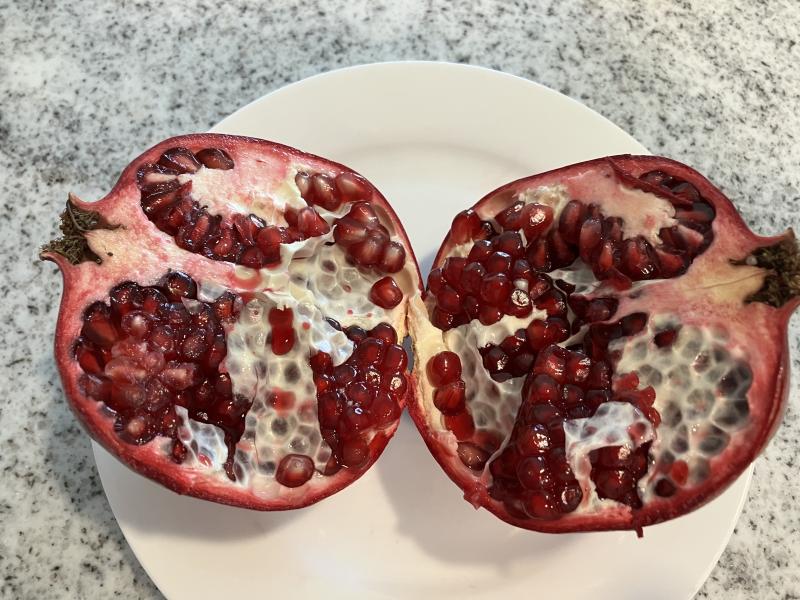Pomegranate seeds provide pops of flavor and color
We’ve entered the season of the pomegranate, time for markets to display pyramids of the round, red fruit filled with juice-encased seeds. Typically available from October through December, this fruit is one of the most labor-intensive to process. About the size of a large orange, pomegranates have a distinctive crown and thin, leathery skin (see photo.) Inside are bitter, fibrous membranes holding hundreds of seeds enclosed in tight, juice-filled pockets.
The seeds are often sold in plastic cups, saving the work to release them, but I have found these often turn bad before I can finish them. It is well worth the investment of time to work with a whole fruit. According to Bon Appetit, the most effective way to release the pips is to hold one half of the fruit over a bowl of water. Using a wooden spoon, vigorously whack the outside rind of the pomegranate and let pieces fall into the water.
Supposedly, the membrane chunks will float to the top and the seeds (aka arils) will sink to the bottom. This happened with my attempt, but only after a fashion. Some of the membranes stayed attached to the seeds, requiring manual separation, and some of the membranes sank to the bottom, necessitating a second step: pour everything into a colander.
After the water drained away, most of the membrane pieces could be picked out, leaving behind a disappointingly small amount of juicy seeds. I decided I would continue my slow and steady approach of using a spoon to scoop a bunch of seeds away from the membrane. So far, I have finished less than a quarter of the whole pomegranate, but I have red dots on every surface in my kitchen!
What is the history of this curious fruit? Both ancient Greeks and Egyptians were familiar with the small pomegranate trees native to Iran, where they still grow wild. Although they’ve been cultivated and appreciated since antiquity, the work to get to the seeds has prevented the fruit from gaining wider popularity. And, there’s the question of what to do with the edible seeds after enjoying the juice surrounding them; spit or swallow are the choices.
When selecting pomegranates, choose those that are heavy for their size, an indication of juiciness. The reddish colors of the rind come in various hues; just be sure to avoid any that are wizened or punctured. Fresh pomegranates can be stored in the refrigerator for up to several weeks. Once the seeds are removed, they should be used within a few days or can be frozen in zip-top bags.
Pomegranate seeds are typically used to garnish a dish, often scattered over salad greens for a bright flavor punch. Because the seeds are so small, juicing them would be a great deal of work. Fortunately, the solution to this challenge is found on grocers’ shelves: bottles of pomegranate juice, sometimes mixed with other fruit juices. Another variation is the Mediterranean ingredient known as pomegranate molasses. This is a syrupy reduction with a rich, tart flavor found in many traditional Persian dishes.
I’ve included a recipe for spinach salad that uses the molasses for the dressing and the seeds as a garnish. The second recipe is a twist on tabouli (tabouleh) salad with crunchy accents from pomegranate seeds and pistachios.
Pomegranate Spinach Salad
10 oz baby spinach
1/4 red onion, thinly sliced
1/2 C crumbled feta cheese
1 T Pomegranate molasses
1 T lemon juice
1 T Balsamic vinegar
2 T olive oil
salt & pepper, to taste
seeds of 1/2 pomegranate
Rinse and drain the spinach, place in a serving bowl. Sprinkle with sliced onions and feta cheese. Whisk together pomegranate molasses, lemon juice, vinegar and olive oil. Drizzle vinaigrette over salad and toss to combine. Season to taste and sprinkle with pomegranate seeds.
Pomegranate Bulgur Salad*
2/3 C medium bulgur
1 pomegranate
3 T lemon juice
2 T honey
1 minced garlic clove
Pinch of ground cinnamon
1/4 C olive oil
salt & pepper, to taste
1 C chopped parsley
1/3 C chopped mint
3 T chopped pistachios
In a large saucepan of salted boiling water, cook the bulgur until just tender, about 15 minutes. Drain well and spread out on a baking sheet to cool. Working over a large bowl to catch any juices, remove the arils from the pomegranate. Transfer 1 T juice (retain pips) to a small bowl. Whisk in lemon juice, honey, garlic and cinnamon. Drizzle in olive oil, whisking constantly until emulsified. Season to taste with salt and pepper. In a serving bowl, combine the bulgur, parsley, mint, lemon zest and reserved pomegranate seeds. Pour in the dressing and toss to evenly coat. Garnish with pistachios. *Adapted from Food & Wine.



















































